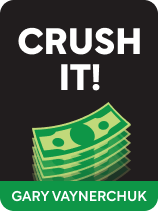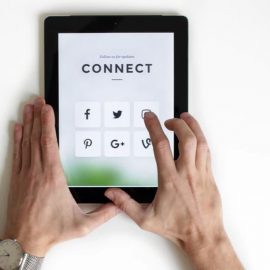

This article is an excerpt from the Shortform book guide to "Crush It!" by Gary Vaynerchuk. Shortform has the world's best summaries and analyses of books you should be reading.
Like this article? Sign up for a free trial here .
Are you growing your personal brand and want to know how to monetize it? What steps can you take to turn your passion into a business?
In his book Crush It!, Gary Vaynerchuk gives advice on how to create and grow your personal brand. He also provides some tips on how to monetize it once it’s up and running.
Here are Vaynerchuck’s tips along with a discussion about the growth of online influencers.
Monetizing Your Brand
Once you’ve established your credibility and gained an engaged community of followers, it’s time to learn how to monetize your passion. These are some ways to earn income through your personal brand.
8 Monetizing Tips from Gary Vaynerchuk
1) Advertising—Vaynerchuk recommends cold-calling companies that are relevant to your niche and asking them to advertise with you directly. (Shortform note: Some brands will have ready-made content for you to post, while others will want you to create the content. If you have to create sponsored content, be sure to charge more. )
| Be Transparent About Your Endorsements Federal Trade Commission (FTC) Guidelines require social media influencers to disclose whenever they have a personal affiliation or paid partnership with a brand they’re endorsing. In an effort to combat deceptive ads online, the policy is fairly thorough: Influencers must disclose if they receive free products, discounts, or perks for mentioning a brand’s products. Likes, tags, pins, and other forms of mentioning a brand can all be considered endorsements. Disclosures must be easy to spot—superimposed on pictures and stated in videos in simple, clear terms. Even with the disclosure, influencers’ endorsements must be honest; they can’t talk about a product they haven’t tried or praise a product they hate. |
2) Affiliate programs—Connect with businesses that sell products you believe in, promote their products, and get a commission when people use your link or code to buy the product. (Shortform note: Since you will be representing the brand, expect the company to thoroughly vet you before partnering for an affiliate program. Brands typically want to see that you have a positive reputation and that you have a large following (at least 5,000 on Instagram).)
3) Merchandise—Create your own products with your logo. They can relate to your niche (like resistance bands, if you have a fitness brand) or be promotional (like T-shirts). (Shortform note: Since authenticity is key to online success, selling your own merchandise is better for your brand than selling someone else’s. Alternatively, you could get the best of both worlds by partnering with an existing brand to design a new product or product line.)
4) Speaking engagements—Find a conference on your niche, think of an original theme, and call the organizers to offer a free presentation. Vaynerchuk says you can start charging after you have five or six under your belt, and, in the meantime, you’ll build credibility and gain exposure to an interested audience. (Shortform note: Building on Vaynerchuk’s advice, look locally for your first few speaking gigs—you’re likely to have more contacts in your area, and if it’s unpaid, you’ll minimize your travel expenses. When you land your first gig, leverage it to get more: Ask the organizers to record your presentation so that you can use it to promote yourself as a speaker, and ask them to provide a testimonial.)
5) Seminars—Host events that give you a chance to share your expertise. Be creative and look for opportunities to partner with other entrepreneurs or local businesses—for example, if you have a fitness brand, put on an informational and training session at a local gym. (Shortform note: Seminars have an earnings ceiling—you can only put on so many seminars each month and year. For a more flexible and profitable approach, many influencers are now developing online courses that bottle their personality and knowledge for mass consumption.)
6) Consulting—As you gain followers and credibility, others will start asking you for advice about your niche or on building a following. Charge them for your time and expertise. (Shortform note: Even when consulting, continue to focus on your niche; while you may be an expert at social media branding as a fitness influencer, your skills and tactics may not work for a travel influencer.)
7) Articles—Write articles for blogs, newsletters, and magazines related to your niche. (Shortform note: First, use Buzzsumo to find publications in your niche. Second, gather three to five samples of your writing to show your chops; you can use past blog posts or write new pieces. Then, send samples to the publication’s editors along with a short, straightforward message with your name, niche, and a snapshot of your online presence and credibility.)
8) TV and book deals—When your credibility and notoriety have grown enough, you’ll get opportunities to broadcast your ideas on bigger platforms, as Perez Hilton and Amanda Congdon have. (Shortform note: When it comes to getting a book deal, publishers are concerned more with the quality of your content than the engagement it generates.)
| The Growth of Influencer Marketing As social media influencers have gained more, well, influence, there’s been an explosion of influencer marketing, where companies pay influencers to promote their products through endorsements and affiliate programs. The market grew steadily in the late 2010s, then spiked to $9.7 billion in 2020, as the pandemic caused people to spend more time online. In 2021, influencer marketing is projected to reach $13.8 billion. Millions of influencers worldwide are already trying to get a piece of the multibillion-dollar pie, and more are constantly joining their ranks. While that has led many people to speculate that the influencer market is becoming saturated, others argue that—though it may be more competitive than in years past—there will always be room for new people with engaging content and interesting perspectives. In fact, hundreds of “influencer marketing solution” businesses have cropped up to help brands find the right influencers to promote their products, based on factors such as: Whether the influencer’s niche and audience match the brand. How often and how consistently they post—An active social media presence should include a daily average of one or two posts each on Facebook and Instagram and about 15 tweets. How engaged their followers are—Companies want to ensure that an influencer’s follower count isn’t padded with bots, and that followers like, comment, and tag friends in the influencer’s posts. How engaged the influencer is—Influencers should respond to followers’ comments and actively engage their audience in their posts. |

———End of Preview———
Like what you just read? Read the rest of the world's best book summary and analysis of Gary Vaynerchuk's "Crush It!" at Shortform .
Here's what you'll find in our full Crush It! summary :
- Step-by-step instructions for building and monetizing a personal brand
- How to quit your day job and earn a living off your brand
- Why a few loyal followers are better than a crowd of passive subscribers






